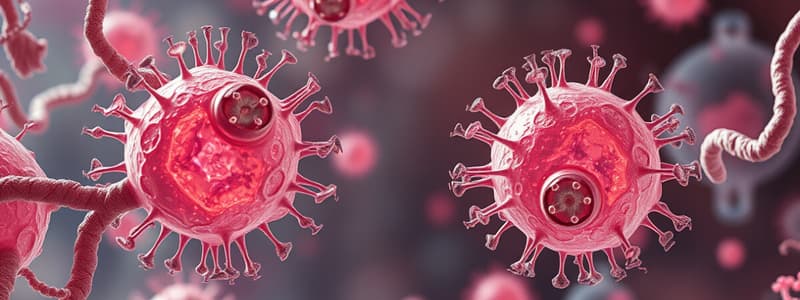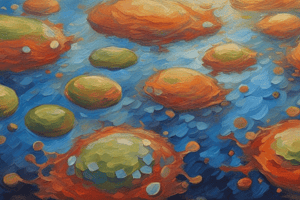Podcast
Questions and Answers
Compare and contrast a human somatic cell to a human gamete.
Compare and contrast a human somatic cell to a human gamete.
Human somatic cells have 46 chromosomes (22 pairs and 2 sex chromosomes), whereas human gametes have 23 chromosomes (one of each chromosome and one sex chromosome).
What is the relationship between a genome, chromosomes, and genes?
What is the relationship between a genome, chromosomes, and genes?
The genome consists of all the chromosomes of an organism, each containing hundreds to thousands of genes.
Explain how chromosomes can fit inside a eukaryotic nucleus.
Explain how chromosomes can fit inside a eukaryotic nucleus.
DNA is wrapped around histone proteins to form nucleosomes, which are coiled into a 30-nm fiber and further condensed during cell division.
Briefly describe the events that occur in each phase of interphase.
Briefly describe the events that occur in each phase of interphase.
What mitotic structure is targeted by chemotherapy drugs like vincristine and colchicine?
What mitotic structure is targeted by chemotherapy drugs like vincristine and colchicine?
Describe the similarities and differences between the cytokinesis mechanisms found in animal cells versus those in plant cells.
Describe the similarities and differences between the cytokinesis mechanisms found in animal cells versus those in plant cells.
List some reasons why a cell that has just completed cytokinesis might enter the G0 phase instead of the G1 phase.
List some reasons why a cell that has just completed cytokinesis might enter the G0 phase instead of the G1 phase.
What cell cycle events will be affected in a cell that produces mutated (non-functional) cohesin protein?
What cell cycle events will be affected in a cell that produces mutated (non-functional) cohesin protein?
Describe the general conditions that must be met at each of the three main cell cycle checkpoints.
Describe the general conditions that must be met at each of the three main cell cycle checkpoints.
Explain the roles of positive cell cycle regulators compared to the negative regulators.
Explain the roles of positive cell cycle regulators compared to the negative regulators.
What steps are necessary for Cdk to become fully active?
What steps are necessary for Cdk to become fully active?
What molecular mechanism does Rb employ to halt the cell cycle?
What molecular mechanism does Rb employ to halt the cell cycle?
Outline the steps that lead to a cell becoming cancerous.
Outline the steps that lead to a cell becoming cancerous.
Explain the difference between a proto-oncogene and a tumor suppressor gene.
Explain the difference between a proto-oncogene and a tumor suppressor gene.
List the regulatory mechanisms that might be lost in a cell producing faulty p53.
List the regulatory mechanisms that might be lost in a cell producing faulty p53.
How does p53 triggering apoptosis benefit a multicellular organism?
How does p53 triggering apoptosis benefit a multicellular organism?
Name the common components of eukaryotic cell division and binary fission.
Name the common components of eukaryotic cell division and binary fission.
Describe how the duplicated bacterial chromosomes are distributed into new daughter cells without the direction of the mitotic spindle.
Describe how the duplicated bacterial chromosomes are distributed into new daughter cells without the direction of the mitotic spindle.
Flashcards are hidden until you start studying
Study Notes
Comparison of Human Cells
- Human somatic cells contain 46 chromosomes (22 pairs + 2 sex chromosomes), in a diploid (2n) state.
- Human gametes have 23 chromosomes (one of each unique chromosome), in a haploid (n) state.
Relationship Between Genome, Chromosomes, and Genes
- The genome is the entirety of an organism's chromosomes.
- Each chromosome holds hundreds to thousands of genes, which are DNA segments coding for proteins or RNA.
Chromosome Structure and Packaging
- DNA wraps around histone proteins, forming nucleosomes.
- Nucleosomes coil into a 30-nm fiber and condense further during cell division with the help of packing proteins.
Interphase Events
- G1 phase: Cell grows, evaluates DNA for damage, and prepares energy/resources for DNA synthesis.
- S phase: Chromosomes and centrosomes duplicate.
- G2 phase: Cell recovers from DNA synthesis, grows, duplicates organelles, and dismantles unnecessary organelles.
Chemotherapy Effects on Mitosis
- Vincristine and colchicine disrupt microtubule assembly by binding to tubulin, targeting the mitotic spindle.
- Disruption leads to inability to sort/separate chromosomes during mitosis, causing cell arrest and death.
Cytokinesis Mechanisms
- Animal cells undergo cytokinesis through a contracting actin ring leading to the formation of a cleavage furrow.
- Plant cells form a new cell wall via a cell plate from Golgi vesicles, which grow and fuse with the parental cell wall.
G0 Phase Entry After Cytokinesis
- Cells can enter G0 for maturity, only proliferating when necessary (tissue injury) or may never divide post-maturity.
Impact of Mutated Cohesin Protein
- Non-functional cohesin affects chromosome packaging post-replication, hindering formation of kinetochores and resulting in failure to sort chromosomes during mitosis.
Cell Cycle Checkpoints Conditions
- G1 checkpoint: Reviews cell size, DNA integrity, energy stores for S phase readiness.
- G2 checkpoint: Confirms chromosome duplication and assesses DNA for errors before proceeding.
- M checkpoint: Ensures correct attachment of spindle fibers to kinetochores.
Cell Cycle Regulators
- Positive regulators (cyclin, Cdk) promote progression through the cell cycle.
- Negative regulators (Rb, p53, p21) halt the cycle until conditions are favorable.
Activation of Cdk
- Cdk requires binding to a cyclin and correct phosphorylation to attain full activity.
Role of Rb in Cell Cycle Regulation
- Active Rb binds E2F, blocking transcription necessary for G1/S transition until the cell size threshold is reached, leading to Rb's phosphorylation and E2F release.
Cancer Development Steps
- Mutations in regulatory genes produce defective proteins, leading to unchecked cell cycle progression and potential cell immortality.
Proto-oncogenes vs Tumor Suppressor Genes
- Proto-oncogenes code for positive cell cycle regulators; mutations can create oncogenes causing abnormal divisions.
- Tumor suppressor genes code for negative regulators; mutations can inactivate them, allowing unchecked cell cycle progression.
Consequences of Faulty p53 Production
- Loss of p53 may impair genomic DNA monitoring, repair enzyme recruitment, and apoptosis initiation.
p53 and Apoptosis
- p53-induced apoptosis from DNA damage prevents faulty protein production in daughter cells, safeguarding the organism by controlling potential cancer formation.
Commonalities in Cell Division
- Both eukaryotic cell division and binary fission involve DNA duplication, segregation of chromosomes, and cytoplasmic division.
Bacterial Chromosome Distribution
- In bacteria, duplicated chromosomes attach to the cell membrane, and as the cell elongates, this assists in distributing them into daughter cells without mitotic spindle direction.
Studying That Suits You
Use AI to generate personalized quizzes and flashcards to suit your learning preferences.




